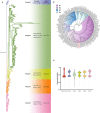Molecular Epidemiology of Herpangina Children in Tongzhou District, Beijing, China, During 2019-2020
- PMID: 35547223
- PMCID: PMC9082675
- DOI: 10.3389/fmed.2022.822796
Molecular Epidemiology of Herpangina Children in Tongzhou District, Beijing, China, During 2019-2020
Abstract
Background: The changing pattern of pathogen spectrum causing herpangina in the time of coronavirus disease 2019 (COVID-19) pandemic was unknown. The purpose of this study was to investigate the changes on the molecular epidemiology of herpangina children during 2019-2020 in Tongzhou district, Beijing, China.
Method: From January 2019 to December 2020, children diagnosed with herpangina were recruited by the staff from Tongzhou Center for Disease Control and Prevention (CDC) in Beijing. Viral RNA extraction from pharyngeal swabs was used for enterovirus (EV) detection and the complete VP1 gene was sequenced. The phylogenetic analysis was performed based on all VP1 sequences for EV genotypes.
Result: A total of 1,331 herpangina children were identified during 2019-2020 with 1,121 in 2019 and 210 in 2020, respectively. The predominant epidemic peak of herpangina children was in summer and autumn of 2019, but not observed in 2020. Compared to the number of herpangina children reported in 2019, it decreased sharply in 2020. Among 129 samples tested in 2019, 61 (47.3%) children were detected with EV, while 22.5% (20/89) were positive in 2020. The positive rate for EV increased since June 2019, peaked at August 2019, and decreased continuously until February 2020. No cases were observed from February to July in 2020, and the positive rate of EV rebounded to previous level since August 2020. Four genotypes, including coxsackievirus A6 (CV-A6, 9.3%), CV-A4 (7.8%), CV-A10 (2.3%) and CV-A16 (10.1%), were identified in 2019, and only three genotypes, including CV-A6 (9.0%), CV-A10 (6.7%) and CV-A16 (1.1%), were identified in 2020. The phylogenetic analysis showed that all CV-A6 strains from Tongzhou located in Group C, and the predominant strains mainly located in C2-C4 subgroups during 2016-2018 and changed into C1 subgroup during 2018-2020. CV-A16 strains mainly located in Group B, which consisting of strains widely distributed around the world.
Conclusions: The predominant genotypes gradually shifted from CV-A16, CV-A4 and CV-A6 in 2019 to CV-A6 in 2020 under COVID-19 pandemic. Genotype-based surveillance will provide robust evidence and facilitate the development of public health measures.
Keywords: COVID-19 pandemic; China; children; herpangina; molecular epidemiology.
Copyright © 2022 Xie, Chen, Yang, Cui, Zhang, Zhao, Zhang, Du, Cui and Lu.
Conflict of interest statement
The authors declare that the research was conducted in the absence of any commercial or financial relationships that could be construed as a potential conflict of interest.
Figures





Similar articles
-
Molecular epidemiology and clinical characteristics of herpangina children in Beijing, China: a surveillance study.PeerJ. 2020 Oct 15;8:e9991. doi: 10.7717/peerj.9991. eCollection 2020. PeerJ. 2020. PMID: 33088614 Free PMC article.
-
Molecular epidemiology of herpangina in the subcenter of Beijing, China: a surveillance study during 2021-2022.Arch Virol. 2024 Nov 15;169(12):245. doi: 10.1007/s00705-024-06171-8. Arch Virol. 2024. PMID: 39546035
-
[Pathogen spectrum in enteroviral infections among children in Beijing from 2010 to 2016].Zhonghua Er Ke Za Zhi. 2018 Aug 2;56(8):575-581. doi: 10.3760/cma.j.issn.0578-1310.2018.08.004. Zhonghua Er Ke Za Zhi. 2018. PMID: 30078237 Chinese.
-
EV-A71 vaccine licensure: a first step for multivalent enterovirus vaccine to control HFMD and other severe diseases.Emerg Microbes Infect. 2016 Jul 20;5(7):e75. doi: 10.1038/emi.2016.73. Emerg Microbes Infect. 2016. PMID: 27436364 Free PMC article. Review.
-
Hand, foot, and mouth disease associated with coxsackievirus A10: more serious than it seems.Expert Rev Anti Infect Ther. 2019 Apr;17(4):233-242. doi: 10.1080/14787210.2019.1585242. Epub 2019 Mar 6. Expert Rev Anti Infect Ther. 2019. PMID: 30793637 Review.
Cited by
-
Epidemiological, etiological, and serological characteristics of hand, foot, and mouth disease in Guizhou Province, Southwest China, from 2008 to 2023.PLoS Negl Trop Dis. 2025 Aug 18;19(8):e0013394. doi: 10.1371/journal.pntd.0013394. eCollection 2025 Aug. PLoS Negl Trop Dis. 2025. PMID: 40825065 Free PMC article.
-
Pathological characteristics of a murine oral coxsackievirus A10 infection model.J Virol. 2025 Jul 22;99(7):e0093725. doi: 10.1128/jvi.00937-25. Epub 2025 Jul 1. J Virol. 2025. PMID: 40590495 Free PMC article.
-
Characteristics and timeliness of intervention in 47 school-based enterovirus outbreaks in Zhejiang Province, China.Front Public Health. 2025 Apr 3;13:1559637. doi: 10.3389/fpubh.2025.1559637. eCollection 2025. Front Public Health. 2025. PMID: 40247874 Free PMC article.
-
A lethal juvenile mouse model for the evaluation of antiviral reagents against coxsackievirus A4.iScience. 2025 Jun 30;28(8):113022. doi: 10.1016/j.isci.2025.113022. eCollection 2025 Aug 15. iScience. 2025. PMID: 40734672 Free PMC article.
-
Molecular epidemiology, coinfection, and diversity of enteroviruses detected in respiratory samples collected from patients with influenza-like illness in Hangzhou, China, in 2023.Virol J. 2025 Jul 8;22(1):227. doi: 10.1186/s12985-025-02862-z. Virol J. 2025. PMID: 40629413 Free PMC article.
References
LinkOut - more resources
Full Text Sources
Miscellaneous

